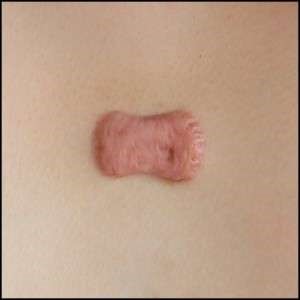Radiation Therapy to Reduce Keloid and Hypertrophic Scars
Keloid and hypertrophic scars are thick, raised scars that often develop after skin injuries, surgeries, or even piercings. These thick scars can be physically uncomfortable and may make some people self-conscious. While some people might find success in treating keloid scars with over-the-counter creams, these do not work for everyone. Surgical removal of the scar often results in recurrence of the scar which is why low-dose electron therapy may be offered to prevent recurrence immediately after removal.

What You Need to Know About Radiation Therapy for Keloid and Hypertrophic Scars
The first thing to know is that radiation scar treatment is safe. Radiation therapy is commonly associated with cancer, and many people are aware of the unpleasant side effects. Radiation therapy for keloid and hypertrophic scars utilizes much lower doses of radiation that are considered safe, with little to no side effects.
The second thing to know is what keloid and hypertrophic scars are. Keloid and hypertrophic scars are essentially the result of the body doing its job too well. When skin is injured, our bodies produce collagen to help heal the wound. In the case of keloid and hypertrophic scars, bodies produce too much collagen, forming thick, raised tissue. These scars vary in color and size and can develop months and even years after an injury. Hypertrophic scars stay within the boundary of the injury that started its formation and keloid scars may spread outside of the area of injury.
Keloid and hypertrophic scars can be itchy and uncomfortable, and in cases where a scar forms over a joint, the thick tissue can make certain movements difficult. It is unclear why some bodies form keloid or hypertrophic scars, but the good news is, radiation therapy can help.
How it Works
Low-dose radiation treatments tackle keloid and hypertrophic scars a couple of different ways. First, it targets inflammation in the body. By lowering the body’s production of naturally occurring chemicals that cause inflammation and stopping inflammatory cells from overcrowding the area, radiation scar treatment helps regulate the body’s healing response. Reducing inflammation also helps to reduce any pain or discomfort a patient may experience from a keloid or hypertrophic scar.
Second, low-dose radiotherapy promotes the activity of healthy tissues. By precisely targeting and treating the keloid or hypertrophic scar area and damaging cells that are behaving abnormally, radiotherapy treatments stop the growth of abnormal tissue while preserving healthy surrounding tissue.
Patients generally receive radiation therapy for a keloid and hypertrophic scars after having the scar surgically removed. In those cases, the radiation treatments help prevent the keloid scar from growing back. Studies show that 80-85% of patients who received radiation scare treatment had no keloid scar regrowth.
What to Expect with Low Dose Radiation Treatment
Radiation therapy for keloid or hypertrophic scars is completely non-invasive, and treatments are very short and generally only 1-4 treatments are required. A machine directs radiation at the affected area for just 30-60 seconds, and then patients can go about their day. Most patients only receive a handful of treatments, although our expert team of radiation oncologists will create a more specific and personalized treatment plan that caters to individual patient needs.
Low-dose radiation scar treatment has almost no side effects. Patients may experience redness at the area of treatment, like a mild sunburn, but this is usually temporary. Our radiation oncologists can answer more questions about the safety and efficacy of radiation scar treatment.
Living with keloid scars can be challenging. In addition to causing pain or discomfort, they can also be a point of embarrassment for some. Thankfully, radiation therapy for keloid and hypertrophic scars is a safe and effective treatment that has proven to be successful in preventing the regrowth of keloids or hypertrophic scars. Learn more about this treatment by visiting Oncology Las Vegas.

